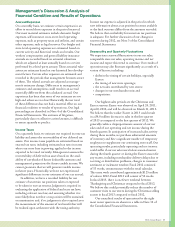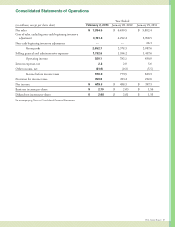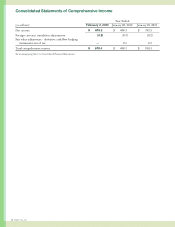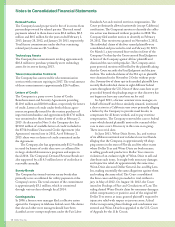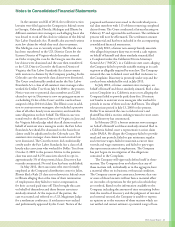Dollar Tree 2012 Annual Report Download - page 35
Download and view the complete annual report
Please find page 35 of the 2012 Dollar Tree annual report below. You can navigate through the pages in the report by either clicking on the pages listed below, or by using the keyword search tool below to find specific information within the annual report.
Notes to Consolidated Financial Statements
Merchandise Inventories
MerchandiseinventoriesattheCompany’sdistribu-
tion centers are stated at the lower of cost or market,
determined on a weighted-average cost basis. Cost is
assigned to store inventories using the retail inventory
method on a weighted-average basis. Under the retail
inventory method, the valuation of inventories at cost
and the resulting gross margins are computed by applying
a calculated cost-to-retail ratio to the retail value of
inventories.Fromitsinceptionthroughscal2009,the
Company used one inventory pool for this calculation.
Because of investments over the years in retail technology
systems,theCompanywasabletorenetheestimateof
inventorycostundertheretailmethod.OnJanuary31,
2010,therstdayofscal2010,theCompanybegan
using approximately thirty inventory pools in its retail
inventory calculation. As a result of this change, the
Company recorded a non-recurring, non-cash charge to
grossprotandacorrespondingreductionininventory,
atcost,ofapproximately$26.3millionintherstquarter
of2010.iswasaprospectivechangeanddidnot
haveanyeectonpriorperiods.ischangeinestimate
to include thirty inventory pools in the retail method
calculation is preferable to using one pool in the calcula-
tion as it gives the Company a more accurate estimate of
cost of store level inventories.
Costs directly associated with warehousing and
distributionarecapitalizedasmerchandiseinventories.
Totalwarehousinganddistributioncostscapitalizedinto
inventoryamountedto$38.8millionand$34.5million
atFebruary2,2013andJanuary28,2012,respectively.
Property, Plant and Equipment
Property, plant and equipment are stated at cost and
depreciated using the straight-line method over the
estimated useful lives of the respective assets as follows:
Buildings 39to40years
Furniture,xturesandequipment 3to15years
Leasehold improvements and assets held under capital
leasesareamortizedovertheestimatedusefullivesofthe
respective assets or the committed terms of the related
leases,whicheverisshorter.Amortizationisincluded
in “selling, general and administrative expenses” in the
accompanying consolidated statements of operations.
Costs incurred related to software developed for
internalusearecapitalizedandamortizedgenerallyover
3years.
Goodwill
Goodwillisnotamortized,butrathertestedforimpair-
ment at least annually. In addition, goodwill will be tested
on an interim basis if an event or circumstance indicates
that it is more likely than not that an impairment loss
has been incurred. e Company performed its annual
impairmenttestinginNovember2012anddetermined
that no impairment loss existed.
Other Assets, Net
Other assets, net consists primarily of restricted invest-
ments and intangible assets. Restricted investments were
$94.6millionand$83.6millionatFebruary2,2013
andJanuary28,2012,respectivelyandwerepurchased
tocollateralizelong-terminsuranceobligations.ese
investments are primarily in tax-exempt money market
funds that invest in short-term municipal obligations.
eseinvestmentsareclassiedasavailableforsale
and are recorded at fair value, which approximates cost.
Intangible assets primarily include favorable lease rights
withniteusefullivesandareamortizedovertheir
respective estimated useful lives.
Impairment of Long-Lived Assets and
Long-Lived Assets to Be Disposed Of
e Company reviews its long-lived assets and certain
identiableintangibleassetsforimpairmentwhenever
events or changes in circumstances indicate that the
carrying amount of an asset may not be recoverable.
Recoverability of assets to be held and used is measured
by comparing the carrying amount of an asset to future
net undiscounted cash flows expected to be generated by
the asset. If such assets are considered to be impaired, the
impairmenttoberecognizedismeasuredastheamount
by which the carrying amount of the assets exceeds the
fair value of the assets based on discounted cash flows or
other readily available evidence of fair value, if any. Assets
to be disposed of are reported at the lower of the carrying
amountorfairvaluelesscoststosell.Inscal2012,2011
and2010,theCompanyrecordedchargesof$0.5million,
$0.9millionand$1.1million,respectively,towritedown
certain assets. ese charges are recorded as a component
of “selling, general and administrative expenses” in the
accompanying consolidated statements of operations.
2012AnnualReport33


